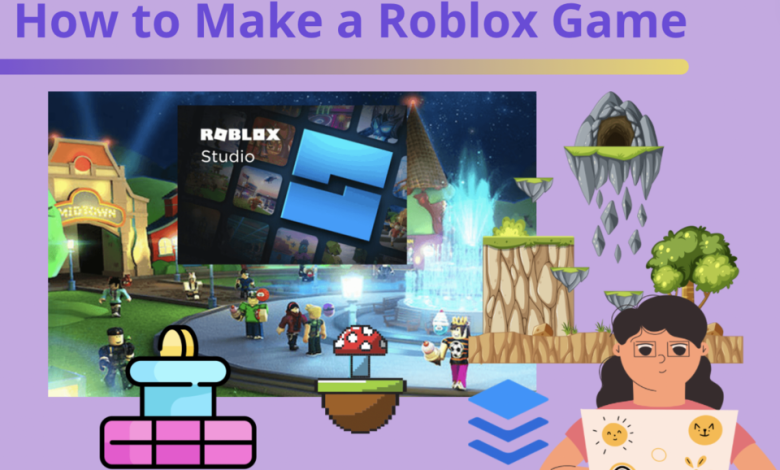How to Make a Roblox Game: A Step-by-Step Guide for Beginners

Roblox is a platform that has captivated millions of users worldwide, allowing them to create and play games across various genres. One of the most exciting aspects of How to make a Roblox game is the ability to create your own games, which can be shared with the community. Whether you’re looking to unleash your creativity, develop coding skills, or simply have fun, making a Roblox game is a rewarding experience. This step-by-step guide will walk you through the process of creating your first Roblox game, from the initial concept to publishing it for others to enjoy.
1. Getting Started: Setting Up Roblox Studio
Before you can begin creating your game, you’ll need to download and install Roblox Studio, the platform’s game development environment.
Step 1: Download Roblox Studio
- Visit the Roblox website and log in to your account.
- Click on the “Create” button at the top of the page, which will redirect you to the Roblox Studio download page.
- Download and install Roblox Studio on your computer.
Step 2: Open Roblox Studio
- Once installed, open Roblox Studio. You’ll be greeted with the start screen, where you can choose to create a new game or open an existing project.
Step 3: Familiarize Yourself with the Interface
- Take some time to explore the Roblox Studio interface. The main components include the Explorer, Properties, and Toolbox panels. Understanding these will help you navigate and manage your game’s assets, scripts, and properties effectively.
2. Choosing a Game Template
Roblox Studio offers various templates to help you get started. These templates come with pre-built elements, such as terrain, characters, and basic scripting, making it easier for beginners to create a game.
Step 1: Select a Template
- On the Roblox Studio start screen, you’ll see a selection of game templates like “Obby,” “Baseplate,” “Racing,” “Tycoon,” and more. Choose a template that best suits the type of game you want to create. For beginners, the “Obby” (obstacle course) or “Baseplate” (a blank slate) templates are good starting points.
Step 2: Customize the Template
- Once the template loads, you can begin customizing it to fit your vision. This includes modifying the terrain, adding new objects, and changing the game’s settings.
3. Building Your Game World
Creating the game world is where your creativity comes into play. You’ll design the environment, place objects, and create the layout of your game.
Step 1: Add and Modify Terrain
- Use the Terrain Editor in the Toolbox to create landscapes such as mountains, valleys, and rivers. You can also add materials like grass, sand, and water to give your world a more realistic appearance.
Step 2: Insert Objects
- The Toolbox contains a vast library of objects, such as trees, buildings, and furniture, that you can place in your game. Simply drag and drop these items into your game world.
Step 3: Adjust Object Properties
- Use the Properties panel to adjust the size, position, color, and other attributes of the objects in your game. You can also add textures and materials to objects to make them more visually appealing.
Step 4: Organize Your Game World
- Organize your game world logically by grouping related objects together. This will make it easier to manage and modify your game later on.
4. Scripting: Bringing Your Game to Life
Scripting is where the magic happens. Roblox uses a programming language called Lua, which allows you to add interactivity and functionality to your game.
Step 1: Understand Basic Lua Scripting
- If you’re new to coding, start by learning the basics of Lua. There are many tutorials and resources available online that can help you get started. Understanding variables, loops, and functions is crucial for creating a functional game.
Step 2: Create a Script
- In Roblox Studio, right-click on an object in the Explorer panel and select “Insert Object” > “Script.” This will create a new script attached to the selected object.
Step 3: Write Your Script
- Open the script editor and start writing your Lua code. For example, if you want to make a door open when a player clicks on it, you would write a script that listens for the click event and then changes the door’s position.
Step 4: Test Your Script
- Regularly test your scripts by clicking the “Play” button in Roblox Studio. This will run your game in a simulation mode, allowing you to see how your code affects the game.
Step 5: Debugging
- If something isn’t working as expected, use the Output panel to check for errors in your script. Debugging is an essential part of the scripting process and helps ensure your game runs smoothly.
5. Adding Game Mechanics
Game mechanics are the rules and systems that govern how your game operates. This includes things like player movement, scoring, and interactions with the game world.
Step 1: Define Your Game’s Core Mechanics
- Decide on the core mechanics of your game. For example, in an Obby game, the core mechanics might include jumping over obstacles, collecting items, and reaching the end of the course.
Step 2: Implement Player Controls
- Roblox provides default controls for player movement, but you can customize these using scripts. For instance, you can create custom jumping mechanics or add special abilities like sprinting or flying.
Step 3: Create Interactions
- Use scripts to create interactions between the player and the game world. This could include things like opening doors, triggering events when a player steps on a specific tile, or collecting items.
Step 4: Implement Scoring and Rewards
- Add a scoring system to keep track of the player’s progress. You can also create rewards for achieving certain milestones, such as unlocking new levels or earning badges.
6. Testing and Debugging
Testing is a crucial step in game development. It allows you to identify and fix any issues before releasing your game to the public.
Step 1: Playtest Your Game
- Regularly playtest your game throughout the development process. This will help you identify any bugs or gameplay issues that need to be addressed.
Step 2: Get Feedback
- Invite friends or other Roblox users to playtest your game. Their feedback can provide valuable insights into areas that need improvement.
Step 3: Debug and Refine
- Use the feedback you receive to refine your game. Fix any bugs, adjust the difficulty level, and polish the game’s mechanics to ensure a smooth and enjoyable experience.
7. Publishing Your Game
Once your game is complete and thoroughly tested, it’s time to publish it on Roblox for others to play.
Step 1: Save Your Game
- Before publishing, make sure to save your game by clicking on “File” > “Save As.” Choose a name for your game and save it in a location where you can easily access it later.
Step 2: Configure Game Settings
- In Roblox Studio, click on the “File” menu and select “Publish to Roblox As.” This will open a window where you can configure your game’s settings, such as the name, description, and privacy options.
Step 3: Choose a Game Thumbnail
- A good thumbnail can attract more players to your game. Roblox allows you to upload a custom image or use an in-game screenshot as the game’s thumbnail.
Step 4: Set Monetization Options (Optional)
- If you want to earn Robux (Roblox’s virtual currency) from your game, you can set up monetization options like game passes, developer products, or in-game purchases.
Step 5: Publish Your Game
- Once you’re satisfied with the settings, click the “Publish” button. Your game will now be available on Roblox for others to play.
8. Promoting Your Game
After publishing your game, the next step is to promote it and attract players.
Step 1: Share with Friends
- Start by sharing your game with friends and encouraging them to play and provide feedback.
Step 2: Use Social Media
- Promote your game on social media platforms like Twitter, Instagram, or YouTube. You can create trailers, gameplay videos, or tutorials to showcase your game.
Step 3: Participate in the Roblox Community
- Join Roblox forums, groups, and Discord servers where you can share your game and connect with other developers. Engaging with the community can help you gain visibility and attract more players.
Step 4: Update Your Game Regularly
- Keep your game fresh by regularly adding new content, features, and bug fixes. This will encourage players to keep coming back and help you build a loyal player base.
Conclusion
Creating a game on How to make a Roblox game is a fulfilling and educational experience that allows you to explore your creativity, develop new skills, and share your creations with the world. While the process may seem daunting at first, following this step-by-step guide will help you build a strong foundation in game development. Remember, the key to success is practice, persistence, and a willingness to learn from both your successes and mistakes. So, fire up Roblox Studio, let your imagination run wild, and start creating your own Roblox game today!









